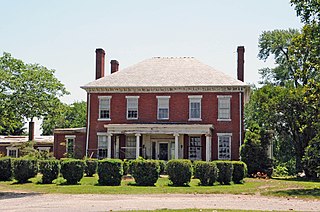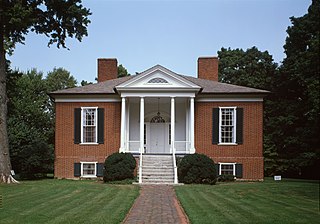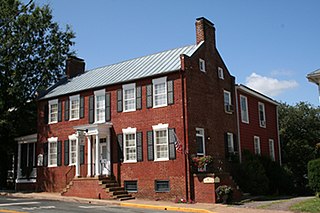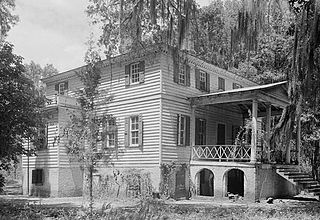
Varina Farms, also known as Varina Plantation or Varina Farms Plantation or Varina on the James, is a plantation established in the 17th century on the James River about 10 miles (16 km) south of Richmond, Virginia. As "Varina Plantation", an 820-acre (330 ha) property was listed on the National Register of Historic Places in 1977. At that time it included two contributing buildings and one other contributing sites.

Gunston Hall is an 18th-century Georgian mansion near the Potomac River in Mason Neck, Virginia, United States. The house was the home of the United States Founding Father George Mason. It was located at the center of a 5,500 acre (22 km²) plantation. The home is also located not far from George Washington's home. The construction period of Gunston Hall was between 1755 and 1759.

Long Grass Plantation is a historic house and national historic district located along what was the Roanoke River basin. In the 1950s most of it was flooded and became the Buggs Island Lake/John H. Kerr Reservoir in Mecklenburg County, Virginia. The house was built circa 1800 by George Tarry on land belonging to his father, Samuel Tarry, and Long Grass Plantation encompassed approximately 2000 acres (8 km2).

Farmington, an 18-acre (7.3 ha) historic site in Louisville, Kentucky, was once the center of a hemp plantation owned by John and Lucy Speed. The 14-room, Federal-style brick plantation house was possibly based on a design by Thomas Jefferson and has several Jeffersonian architectural features.

The I-house is a vernacular house type, popular in the United States from the colonial period onward. The I-house was so named in the 1930s by Fred Kniffen, a cultural geographer at Louisiana State University who was a specialist in folk architecture. He identified and analyzed the type in his 1936 study of Louisiana house types. He chose the name "I-house" because of its common occurrence in the rural farm areas of Indiana, Illinois and Iowa, all states beginning with the letter "I". He did not use the term to imply that this house type originated in, or was restricted to, those three states. It is also referred to as Plantation Plain style.

Mount Airy, near Warsaw in Richmond County, Virginia, built in 1764, is a mid-Georgian plantation house, the first built in the manner of a neo-Palladian villa. Colonel John Tayloe II, perhaps the richest Virginia planter of his generation, constructed it. His daughter Rebecca and her husband, Francis Lightfoot Lee, one of the only pair of brothers to sign the Declaration of Independence are buried on the estate, as are many other Tayloes. Before the American Civil War, Mount Airy was a prominent racing horse farm, as well as headquarters of about 10-12 separate slave plantations along the Rappahannock River. Mount Airy is listed on the National Register of Historic Places as a National Historic Landmark as well as on the Virginia Landmarks Register, and is still privately owned by Tayloe's descendants.

The Thomas Paine Cottage in New Rochelle, New York, in the United States, was the home from 1802 to 1806 of Thomas Paine, author of Common Sense and Revolutionary War hero. Paine was buried near the cottage from his death in 1809 until his body was disinterred in 1819. It was one of a number of buildings located on the 300 acre farm given to Paine by the State of New York in 1784, in recognition of his services in the cause of Independence. It was here in August 1805 that he wrote his last pamphlet, which was addressed to the citizens of Philadelphia on "Constitutional Reform".

Ridgedale is a 19th-century Greek Revival plantation house and farm on a plateau overlooking the South Branch Potomac River north of Romney, West Virginia, United States. The populated area adjacent to Washington Bottom Farm is known as Ridgedale. The farm is connected to West Virginia Route 28 via Washington Bottom Road.

The Laura Ingalls Wilder House is a historic house museum at 3060 Highway A in Mansfield, Missouri. Also known as Rocky Ridge Farm, it was the home of author Laura Ingalls Wilder from 1896 until her death in 1957. The author of the Little House on the Prairie series, Wilder began writing the series while living there. The house, together with the nearby Rock Cottage on the same property, represents one of the few surviving places where she resided. Shortly after her death local residents initiated legal steps to acquire the house through the incorporation of a non-profit organization to preserve her legacy. Owned by the Laura Ingalls Wilder Home Association, the house is open to the public for tours. It was designated a National Historic Landmark in 1991.

Roaring River State Park is a public recreation area covering of 4,294 acres (1,738 ha) eight miles (13 km) south of Cassville in Barry County, Missouri. The state park offers trout fishing on the Roaring River, hiking on seven different trails, and the seasonally open Ozark Chinquapin Nature Center.

Fairfield Plantation, also known as the Lynch House is a plantation about 5 mi (8 km) east of McClellanville in Charleston County, South Carolina. It is adjacent to the Wedge Plantation and just north of Harrietta Plantation. The plantation house was built around 1730. It is located just off US Highway 17 near the Santee River. It was named to the National Register of Historic Places on September 18, 1975.

The A.W. Patterson House is a historic house in Muskogee, Oklahoma. Located at the intersection of 14th Street and West Okmulgee, it is situated at the crest of a hill near the western edge of the downtown Muskogee neighborhood. It was built in 1906, before Oklahoma achieved statehood in 1907. It was listed on the National Register of Historic Places in 1984.

The Thomas and Maria Blackman Bartlett House was built as a private house at the corner of Canton Center and Warren Roads. It was donated to Canton Township and relocated to its current site at 500 N. Ridge Road in Cherry Hill, Michigan. It was listed on the National Register of Historic Places in 2000.

Susina Plantation is an antebellum Greek Revival house and several dependencies on 140 acres near Beachton, Georgia, approximately 15 miles (24 km) southwest of the city of Thomasville, Georgia. It was originally called Cedar Grove. The house is listed on the National Register of Historic Places, and is currently a private residence.

The Walnut Hill Historic District is a collection of 40 family dwellings, agricultural outbuildings, and other structures and sites associated with the Walnut Hill Plantation and the Mial-Williamson and Joseph Blake farms near Shotwell, North Carolina. The historic district represents the post-Civil War growth of one of the largest agricultural centers in Wake County. It is situated primarily along the northeast end of Mial Plantation Road between its intersections with Major Slade and Smithfield Roads.

The Saxon Lutheran Memorial in Frohna, Missouri, commemorates the German Lutheran migration of 1838/1839, and features a number of log cabins and artifacts from that era. The memorial opened in 1962 and was placed on the National Register of Historic Places in 1980.

The Ford–Countess House is a historic residence near Huntsville in Madison County, Alabama. Hezekiah Ford came to Madison County from Cumberland County, Virginia, in 1813, and began purchasing land on which to build a cotton plantation. He acquired the land on which the house stands in 1820, and built the two-story, brick I-house soon after. Ford died in 1839, and the land was owned by his wife, Nancy, until her death in 1844. Hezekiah's brother, John, then assumed ownership, and the plantation stayed in his family until 1904. It reached a peak of 280 acres, and the family owned 69 slaves in 1860. James W. Burcum owned the property from 1904 until 1911, when it was sold to Stephen H. Countess of Tuscaloosa. The Countess family still owns and farms the land, although the house has not been occupied since 1995.

Rountree Family Farm, also known as the Alfred Patrick Rountree Farm, is a historic farm complex located near Gatesville, Gates County, North Carolina. The property consists of the property, buildings and outbuildings constructed by four generations of the descendants of Abner Rountree who acquired the family's original holding here in 1800. The Simmons Rountree House was built about 1830, and is a two-story, one-room plan frame house. It has not been occupied as a residence since 1907. The Alfred Patrick Rountree House was built in 1904 and expanded about 1916. It is a two-story frame farmhouse sheathed in weatherboard. Also on the property are the contributing dairy, hand-pump, wood shed, smokehouse, privy, three barns, stable, and chicken coop.

The Josiah Davis House, south of Canoochee in Emanuel County, Georgia, is a Plantation Plain-style house built in 1869 on a 321 acres (130 ha) property. The property, with six contributing buildings, was listed on the National Register of Historic Places in 1982.

The Roberts-Bush-Roberts House was listed on the National Register of Historic Places in 2015.
























